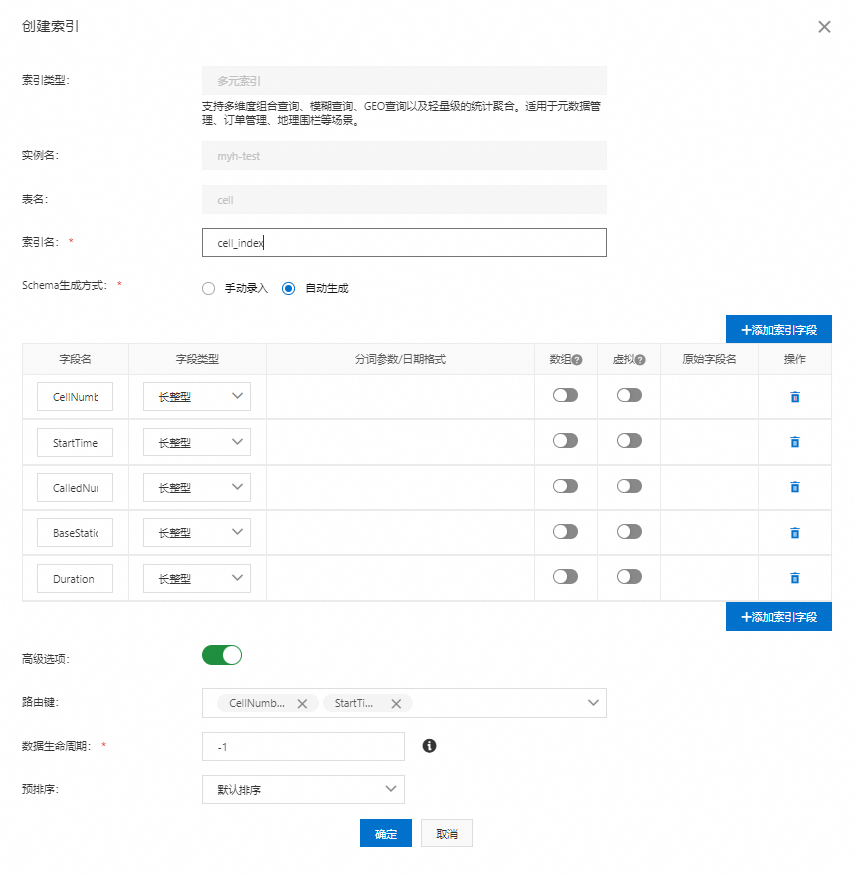创建多元索引时,您可以选择部分主键列作为路由字段,在进行索引数据写入时,表格存储会根据路由字段的值计算索引数据的分布位置,路由字段的值相同的记录会被索引到相同的数据分区中。
使用流程
创建索引时,指定一个或多个路由字段。
您在创建多元索引时指定了路由字段后,索引数据的读写都会使用该路由字段进行定位。
多元索引的路由键支持动态改变。如果想使用系统默认路由(即主键列路由)或者重新指定其他字段为路由字段,您可以通过动态修改schema功能实现路由键修改。更多信息,请参见动态修改schema。
重要路由字段只能是表格存储的主键列。
在索引查询时,在查询请求中指定路由字段值。
查询数据时使用路由定向搜索指定数据分区,可以减少长尾对延迟的影响。对于自定义路由的查询请求,都要求用户提供路由字段。如不指定路由键,虽然查询结果一样,但查询时会访问无关的数据分区,浪费系统资源,增加访问延迟。
重要路由键可配置为单值或多值,不支持范围。
使用方式
您可以使用控制台、命令行工具或者SDK进行路由键配置。路由键支持在创建多元索引时配置或者在创建多元索引后修改。此处以创建多元索引时配置路由键为例介绍。
在创建多元索引后,如需修改多元索引的路由键,请通过动态修改schema实现。具体操作,请参见动态修改schema。
已创建数据表,且数据表的最大版本数(max Versions)必须为1,数据生命周期(Time to Live)必须满足如下条件中的任意一个。具体操作,请参见数据表操作。
数据表的数据生命周期为-1(数据永不过期)。
数据表的数据生命周期不为-1时,数据表为禁止更新状态(即是否允许更新为否)。
使用SDK方式进行操作时,还需要完成初始化Client。具体操作,请参见初始化OTSClient。
使用命令行工具方式进行操作前,还需要完成下载并启动命令行工具,然后配置接入实例信息。具体操作,请参见下载命令行工具和启动并配置接入实例。
使用命令行工具
通过命令行工具执行create_search_index命令创建多元索引。更多信息,请参见多元索引。
创建多元索引时指定路由键。
以下示例用于创建名称为mysearchindex的多元索引,该多元索引有gid(long类型)、uid(long类型)、col2(long类型)、col3(text类型)、col1(keyword类型)何col3V(long类型)字段。其中col3V为虚拟列,对应原始列为col3。多元索引的路由键配置为uid。
create_search_index -n mysearchindex根据系统提示输入索引schema,请根据实际字段修改示例后再使用。示例如下:
{ "IndexSetting": { "RoutingFields": ["uid"] }, "FieldSchemas": [ { "FieldName": "gid", "FieldType": "LONG", "Index": true, "EnableSortAndAgg": true, "Store": true, "IsArray": false, "IsVirtualField": false }, { "FieldName": "uid", "FieldType": "LONG", "Index": true, "EnableSortAndAgg": true, "Store": true, "IsArray": false, "IsVirtualField": false }, { "FieldName": "col2", "FieldType": "LONG", "Index": true, "EnableSortAndAgg": true, "Store": true, "IsArray": false, "IsVirtualField": false }, { "FieldName": "col3", "FieldType": "TEXT", "Index": true, "Analyzer": "single_word", "AnalyzerParameter": { "CaseSensitive": true, "DelimitWord": null }, "EnableSortAndAgg": false, "Store": true, "IsArray": false, "IsVirtualField": false }, { "FieldName": "col1", "FieldType": "KEYWORD", "Index": true, "EnableSortAndAgg": true, "Store": true, "IsArray": false, "IsVirtualField": false }, { "FieldName": "col3V", "FieldType": "LONG", "Index": true, "EnableSortAndAgg": true, "Store": true, "IsArray": false, "IsVirtualField": true, "SourceFieldNames": [ "col3" ] }] }使用多元索引查询数据时指定路由键。
以下示例用于使用mysearchindex查询col2列小于200的行数据。查询时带有多元索引路由键uid。
search -n search_index --return_all_indexed根据系统提示输入查询条件,请根据实际字段修改示例后再使用。示例如下:
说明此处以RangeQuery(范围查询)为例介绍,如需使用其他查询方式,请参见多元索引基础功能。
{ "Offset": -1, "Limit": 10, "Collapse": null, "Sort": null, "GetTotalCount": true, "Token": null, "IndexSetting": { "RoutingFields": ["uid"] }, "Query": { "Name": "RangeQuery", "Query": { "FieldName": "col2", "From": null, "To": 200, "IncludeLower": false, "IncludeUpper": false } } }
使用SDK
您可以使用Java SDK、Go SDK、Python SDK、Node.js SDK、.NET SDK和PHP SDK在创建多元索引时配置路由键。此处以Java SDK为例介绍路由键的配置和使用。
以下示例用于创建order数据表时创建order_index多元索引并指定路由字段为user_id字段。然后写入数据并带上路由字段进行查询。该数据表有order_id(string类型)和user_id(string类型);该多元索引有product_name(keyword类型)、order_time(long类型)和user_id(keyword类型)字段,多元索引的路由键为user_id字段。
private static void testRoute(SyncClient client) throws InterruptedException {
//创建表。
TableMeta meta = new TableMeta("order");
meta.addPrimaryKeyColumn("order_id",PrimaryKeyType.STRING);
meta.addPrimaryKeyColumn("user_id",PrimaryKeyType.STRING);
TableOptions options = new TableOptions();
options.setMaxVersions(1);
options.setTimeToLive(-1);
CreateTableRequest request = new CreateTableRequest(meta,options);
request.setReservedThroughput(new ReservedThroughput(new CapacityUnit(0, 0)));
CreateTableResponse response = client.createTable(request);
//创建多元索引并指定路由字段。
CreateSearchIndexRequest searchIndexRequest = new CreateSearchIndexRequest();
//订单表。
searchIndexRequest.setTableName("order");
//订单表索引名。
searchIndexRequest.setIndexName("order_index");
IndexSchema indexSchema = new IndexSchema();
IndexSetting indexSetting = new IndexSetting();
//设置user_id为路由字段。
indexSetting.setRoutingFields(Arrays.asList("user_id"));
indexSchema.setIndexSetting(indexSetting);
//添加索引字段。此处只是给出示例,您可以根据业务需求添加索引字段。
indexSchema.setFieldSchemas(Arrays.asList(
new FieldSchema("product_name",FieldType.KEYWORD).setStore(true).setIndex(true),
new FieldSchema("order_time",FieldType.LONG).setStore(true).setEnableSortAndAgg(true).setIndex(true),
new FieldSchema("user_id",FieldType.KEYWORD).setStore(true).setIndex(true)
));
searchIndexRequest.setIndexSchema(indexSchema);
client.createSearchIndex(searchIndexRequest);
//等待数据表加载。
Thread.sleep(6*1000);
//插入一些测试数据。
String[] productName = new String[]{"product a", "product b", "product c"};
String[] userId = new String[]{"00001", "00002", "00003", "00004", "00005"};
for (int i = 0; i < 100; i++){
PrimaryKeyBuilder primaryKeyBuilder = PrimaryKeyBuilder.createPrimaryKeyBuilder();
primaryKeyBuilder.addPrimaryKeyColumn("order_id",PrimaryKeyValue.fromString(i+""));
primaryKeyBuilder.addPrimaryKeyColumn("user_id",PrimaryKeyValue.fromString(userId[i%(userId.length)]));
PrimaryKey primaryKey = primaryKeyBuilder.build();
RowPutChange rowPutChange = new RowPutChange("order",primaryKey);
//写入属性列。
rowPutChange.addColumn("product_name",ColumnValue.fromString(productName[i%(productName.length)]));
rowPutChange.addColumn("order_time",ColumnValue.fromLong(System.currentTimeMillis()));
rowPutChange.setCondition(new Condition(RowExistenceExpectation.IGNORE));
client.putRow(new PutRowRequest(rowPutChange));
}
//等待数据同步到多元索引。
Thread.sleep(20*1000);
//带上路由字段的查询。
SearchRequest searchRequest = new SearchRequest();
searchRequest.setTableName("order");
searchRequest.setIndexName("order_index");
MatchQuery matchQuery = new MatchQuery();
matchQuery.setFieldName("user_id");
matchQuery.setText("00002");
SearchQuery searchQuery = new SearchQuery();
searchQuery.setQuery(matchQuery);
searchQuery.setGetTotalCount(true);
SearchRequest.ColumnsToGet columnsToGet = new SearchRequest.ColumnsToGet();
columnsToGet.setReturnAll(true);
searchRequest.setColumnsToGet(columnsToGet);
searchRequest.setSearchQuery(searchQuery);
PrimaryKeyBuilder pkbuild = PrimaryKeyBuilder.createPrimaryKeyBuilder();
pkbuild.addPrimaryKeyColumn("user_id",PrimaryKeyValue.fromString("00002"));
PrimaryKey routingValue = pkbuild.build();
searchRequest.setRoutingValues(Arrays.asList(routingValue));
SearchResponse searchResponse = client.search(searchRequest);
System.out.println(searchResponse.isAllSuccess());
System.out.println("totalCount:"+ searchResponse.getTotalCount());
System.out.println("RowCount:"+searchResponse.getRows().size());
}
